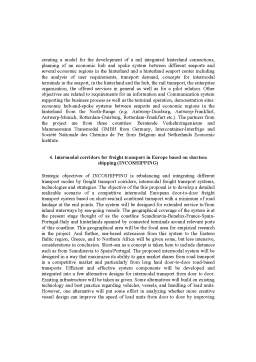Extras din referat
Abstract: Characterized by scientific methodologies and approaches, research activities are desired to amplify the benefits from maritime transport initiatives. Through research developments projects, the maritime-based logistics concepts replace simple transport with high quality services, orientated towards the construction of a veritable alternative to road transport. The paper is presenting four projects with transnational partners with objectives of developing the maritime infrastructure, transport services, logistics and management.
Maritime transport not only acts as the backbone of international trade, it also offers great potential for intra-community commercial exchanges Research activities have a major implication and a socioeconomic impact in the market and financial strategies, operational and organisational optimization. The research development projects provides application of new technologies and influence in an effective way ports, terminal operations and maritime safety. One good example in this sense is the “International Loading Unit” concept, which updates the lorry from a conventional transport vehicle to a loading unit in the intermodal transport that is interoperable between road, rail and maritime modes. Other research developments and strategies are presented as follows.
1. Six Sigma
Developments research invested considerable resources and joined efforts in transnational research areas to develop domains like transport network and logistical services.
In the early nineties, many COST Actions (Cooperation in Science and Technology) started to address the technical and organisational problems of maritime
transport. The results of the research actions provide useful solutions and some of them can be considered essential technologies for the development of sea motorway concepts. In the United States, The Gulf Coast Region Maritime Technology Center worked closely with the Central Region of the U.S. Department of Transportation Maritime Administration (MARAD) and Bollinger Gulf Repair (BGR) facilitating implementation of Six Sigma and integrating state of the art management techniques. Six Sigma is a set of practices originally developed by Motorola to systematically improve processes by eliminating defects. The term “Sigma” is often used as a scale for levels of “goodness” or quality. Using this scale, “Six Sigma” equates to 3.4 defects per one million opportunities. Therefore, Six Sigma started as a defect reduction effort in manufacturing and was then applied to other business processes for the same purpose. Six Sigma is a business improvement methodology that focuses an organization on understanding and managing customer requirements, aligning key business processes to achieve those requirements, utilizing rigorous data analysis to minimize variation in those processes and driving rapid and sustainable improvement to business processes. Six Sigma asserts that continuous efforts to reduce variation in process outputs is key to business success, manufacturing and business processes can be measured, analyzed, improved and controlled, succeeding at achieving sustained quality improvement requires commitment from the entire organization, particularly from top-level management. The reality is that metrics and terminology have not been standardized across the maritime industry, impeding the measurement and comparison of performance. Lean Six Sigma provides the core capabilities to define performance metrics that everyone can understand and to drive measurable process improvements for the benefit of both ports and shippers.
Implementation of Lean Six Sigma is expanding to the commercial shipping industry in the United States. Given the diversity of process-level factors that affect port and ship operator capabilities, Lean Six Sigma is essential to sort out the factors that are most important to maritime operations. As a result, both ports and shippers are able to make continuous improvements in competitiveness, efficiency, safety and environmental responsiveness in the face of the industry’s relentless growth. MARAD applied the Six Sigma strategy in ship coating applications as paint represents the highest cost item and the most growth work during a typical ship dry-dock. The results of this project showed significant savings by MARAD and BGR.
Bibliografie
Olof Persson, Patrik Kosowski, Development and evaluation of dispatching strategies for the IPSI- AGV system, Blekinge Tekniska Högskola/TEK 2006
Zhaomin Zhang, Modernising European short sea shipping links, Neptune, European Communities, Belgium, 2006
***, College partners with maritime shipping company, ExecDigital, August News,U.S., 30 August 2007
***, Intermodal corridors for freight transport in Europe based on shortsea shipping, Proposal summary
***, Pioneering efforts to deploy Lean Six Sigma in maritime shipping operations featured in Marine, News Linthicum, MD, November 1, 2006
***, The motorways of the sea “Preparing the future” Ministerial Conference on the Motorway of the Sea, Ljubljana, Slovenia, 24 January 2006, conclusions adopted by the conference.
http://www.onr.navy.mil/sci_tech/
http://www.motorola.com/content.jsp?globalObjectId=3088
http://www.maritime-safety.org/
http://cordis.europa.eu/transport/src/ipsi.htm
Preview document
Conținut arhivă zip
- A Transnational Approach of Research Developments in Maritime Transport.doc











